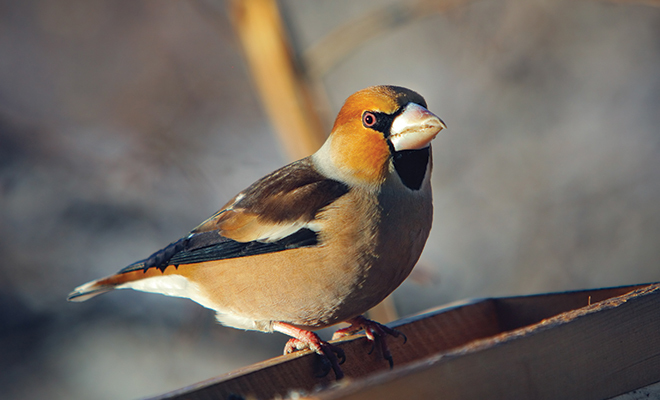
It’s strictly for the birds!
It’s a drizzly day as I sit in the kitchen of Harriet Wright, looking through the picture window at a landscape that’s alive with birds. “If you had been here this morning, you would have seen our pair of red-shouldered hawks!” she beams.
When I was six years old, I sat at this same table as we baked cookies and Harriet, then, of course, Mrs. Wright, my neighbor, a founder and past president of the local Audubon Society chapter, opened my eyes to the myriad species of ornithological wonders populating her semi-rural seven acres. Before suburban sprawl affected the neighborhood, more than 100 acres were literally teeming with wildlife. But construction, time and years have not diminished Harriet’s love for nature’s winged creatures.
“When you’re developing a landscape or adapting your environment to attract birds, you must include the three things that birds need most, and those are food, water and shelter,” Harriet specifies. “There are hundreds of ways to do this. Identify your local native and also migrating species, and then you just supply them what they want!”
Food sources can be natural, supplied by native plants, shrubs and grasses that provide berries and seeds as flowers and pods mature. “You can tell what a bird eats by the shape of its beak. A cone-shaped bill is for cracking seeds, and is found on cardinals, finches, grosbeaks and sparrows. The slender, pointed beak of the warbler family is used for picking insects off foliage. The strong, tapered beak of the woodpecker, of course, chisels into trees for insects and to create nesting spots.” Sunflower seeds or chips, millet and thistle seeds are some that create her bird buffet, set on various platforms and in feeders with openings of sizes appropriate to the seed diameter. She sets out water-plumped golden raisins for the orioles. “That’s extreme feeding; so is providing live and frozen meal worms for my bluebirds.
“But I have never seen a bird that doesn’t love suet!” Harriet laughs. She visits the local grocer’s butcher regularly to collect the fat scraps from trimmed meat. “The butcher is tickled to help; he grinds the scraps up and gives me, free, a three- or four-pound plastic bag full. I form it into balls and set it out; the hawks particularly love it.” She also creates a “magic mix” consisting of creamy peanut butter, lard or bacon grease, any kind of syrup, and enough plain white corn meal to make soft balls that are pressed into wide, shallow holes drilled into an old branch. It provides nutrition and energy, and the birds devour it.
Cover is essential to provide nesting places, favorite roosting spots and habitat to hide from predators. Trees, both deciduous and evergreen and, again, native species, are favorable. Boxes or containers can be provided that are adapted to the native and perhaps migratory species in your environment. “Bluebird boxes are among my favorite; they can’t peck a hole in a tree like a woodpecker. The bluebird needs a deep box with a one-and-a-half-inch opening; it’s important to be able to clean out the box after the babies fledge, because the mother bird wants a clean box.” Other larger species may require a box up to 18 inches deep.
Water is the third necessity. Since it’s raining today, all sorts of plant saucers, bird baths and depressions in the yard are full. There’s an old two-inch thick concrete bird bath on the ground next to a resin bird bath on a pedestal. “The base to the concrete basin crumbled years ago, but it’s never frozen because it’s too thick,” she informs me. “You can find any size or shape of bird bath at the specialty stores, but it’s important to keep it full and clean. Some climates are prone to mosquito infestations, so that’s another reason, especially now with the Zika threat, to keep the bird baths and water sources clean and refreshed.”
I notice an orange extension cord running across the patio into the grass, and inquire about it. Harriet grins widely. “That’s our heater! It’s running to the two big bird baths. It’s so important to keep the water from freezing, since they need it all year in any climate.” There are solar heaters on the market, but this is a simple immersion heater; an alternative is a specialty bird bath with the heating element built into the bowl.
“There’s never been a time that I didn’t find joy in birds and nature,” Harriet affirms. I hope you’ll find ways to share that pleasure also! HLM
Sources: fsc.fernbank.edu; duncraft.com and auduboninternational.org.
Cooking for the Birds
Harriet’s special recipe for Bird Pudding contains great nutrition and is irresistible to birds of all species.
1 cup lard
1 cup crunchy peanut butter
1 cup flour
2 cups quick-cooking oatmeal
2 cups plain white cornmeal
Melt lard and peanut butter together; mix in the dry ingredients. It will be thick; spread in a standard baking pan and refrigerate. Cut into brownie-sized squares, place on a platform feeder or in wire cage and watch the birds flock!







